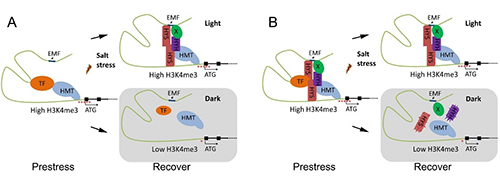PNAS:中科院植物所华学军与金京波研究组揭示植物盐胁迫记忆调
2016年12月7日,国际著名学术期刊《美国国家科学院院刊》杂志在线发表了中国科学院植物研究所华学军研究组与金京波研究组合作的一篇研究论文,论文揭示了一种植物盐胁迫记忆调控新机制。华学军组博士研究生冯宣军为该论文的第一作者,研究员华学军与金京波为共同通讯作者。
为适应复杂多变的环境,植物能够对经历过的不利环境刺激产生一定的“记忆”,从而有利于更快更强地应对再次出现的胁迫。然而,人们对植物的胁迫“记忆”是否受其他环境因素的调节还知之甚少。
研究人员针对植物盐胁迫“记忆”的调控机制展开了研究。研究人员发现,拟南芥对盐胁迫诱导的脯氨酸积累及脯氨酸合成的关键酶基因P5CS1 转录表达具有“记忆”能力,并且这种“记忆”依赖于胁迫恢复阶段的光照和HY5介导的光信号通路。HY5/HYH通过与P5CS1启动子特定片段的结合,帮助维持胁迫恢复阶段P5CS1 转录起始点附近的组蛋白甲基化(H3K4me3)修饰。这一研究结果揭示了转录因子结合启动子上游片段来维持H3K4me3水平,从而调控植物胁迫“记忆”的新机制。

光信号影响盐胁迫下P5CS1的转录“记忆”调控机制,(A)和(B)为两种可能模型示意图
原文链接:
Light affects salt stress-induced transcriptional memory ofP5CS1 in Arabidopsis
原文摘要:
To cope with environmental stresses, plants often adopt a memory response upon primary stress exposure to facilitate a quicker and stronger reaction to recurring stresses. However, it remains unknown whether light is involved in the manifestation of stress memory. Proline accumulation is a striking metabolic adaptation of higher plants during various environmental stresses. Here we show that salinity-induced proline accumulation is memorable and HY5-dependent light signaling is required for such a memory response. Primary salt stress induced the expression of Δ1-pyrroline-5-carboxylate synthetase 1 (P5CS1), encoding a proline biosynthetic enzyme and proline accumulation, which were reduced to basal level during the recovery stage. Reoccurring salt stress-induced stronger P5CS1 expression and proline accumulation were dependent upon light exposure during the recovery stage. Further studies demonstrated that salt-induced transcriptional memory of P5CS1 is associated with the retention of increased H3K4me3 level at P5CS1during the recovery stage. HY5 binds directly to light-responsive element, C/A-box, in the P5CS1 promoter. Deletion of the C/A-box or hy5 hyh mutations caused rapid reduction of H3K4me3 level at P5CS1 during the recovery stage, resulting in impairment of the stress memory response. These results unveil a previously unrecognized mechanism whereby light regulates salt-induced transcriptional memory via the function of HY5 in maintaining H3K4me3 level at the memory gene.
作者:华学军与金京波

